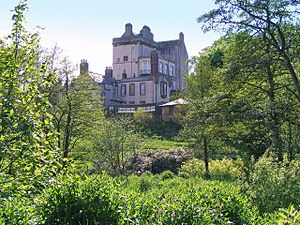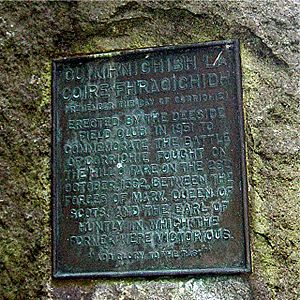Battle of Corrichie facts for kids
Quick facts for kids Battle of Corrichie |
|||||||
|---|---|---|---|---|---|---|---|
| Part of Mary, Queen of Scots Civil Wars | |||||||
 Monument to the Battle of Corrichie |
|||||||
|
|||||||
| Belligerents | |||||||
Clan Fraser Clan Munro Clan Mackenzie Clan Mackintosh Clan Mackay Clan Murray Clan Forbes Clan Cameron |
Rebels: Clan Gordon Clan Brodie |
||||||
| Commanders and leaders | |||||||
| Earl of Moray Earl of Atholl Earl of Morton |
Earl of Huntly | ||||||
| Strength | |||||||
| 2,000 | 500 | ||||||
| Casualties and losses | |||||||
| None | 120 killed 100 captured |
||||||
The Battle of Corrichie was a fight that happened near Meikle Tap, in Scotland. It took place on October 28, 1562. The battle was between the forces of George Gordon, 4th Earl of Huntly and the army of Mary, Queen of Scots. Queen Mary's forces were led by her half-brother, James Stewart, 1st Earl of Moray.
Even though Huntly had won a battle against the English years before, he lost at Corrichie. He died shortly after being captured. Queen Mary had traveled to northern Scotland to challenge the power of the Gordon family. At Corrichie, the Gordons tried to attack with swords. But Moray's soldiers used a strong formation of long spears, called a pike drill, which helped them win.
Contents
Why the Battle Happened: The Background Story
Historians like George Buchanan wrote about the events leading up to 1562. The Earl of Huntly felt he had lost important lands, called earldoms, to the new Earl of Moray. This made Huntly angry and an enemy of Moray, who was Queen Mary's half-brother.
In August 1562, Queen Mary and Moray arrived in Aberdeen. They met with the Earl and Countess of Huntly. A big problem was what to do with Huntly's son, John Gordon. Queen Mary wanted him to be held in Stirling Castle. There had even been talk of John marrying Mary, but this was likely a way to control his father.
Mary and Huntly traveled towards Huntly Castle. But the Queen became impatient because Huntly would not hand over his son. She turned back before reaching the castle. An English diplomat, Thomas Randolph, said Mary got very close to Huntly Castle. He described the castle as "fair" and well-furnished.
The Queen's Journey North
Next, Mary and her court went to Inverness Castle. But the Gordon captain in charge refused to give the castle to the Queen's representative. At this point, some clans, like the Clan Chattan, left Huntly's side and joined the Queen. Other ancient Scottish clans, like the Frasers and Munros, also came to help Mary.
They easily took Inverness Castle on September 9. The Gordon soldiers guarding it were punished, and their captain was executed. After this, Mary and her court returned to Aberdeen. Huntly tried to find out what the Queen planned to do. He used his cousin, the Earl of Sutherland, to get information. But Sutherland's messages were found, and he had to run away. By now, Huntly was very close to Aberdeen, at Corrichie.
More Reasons for Conflict
Thomas Randolph, the English diplomat, wrote letters that give more details. He said Huntly had a royal cannon at his castle, which he had received from Regent Arran. Queen Mary demanded it back quickly. On October 9, her men went to Huntly Castle to capture the Earl. But he escaped over a low wall. The Countess of Huntly stayed at the castle, while the Earl went to his house at Badenoch. He was officially declared a rebel on October 17.
Another event that angered the Queen was mentioned by John Knox. Mary had sent Captain Stewart with 60 men to take Findlater Castle. But Huntly's son, John Gordon, surprised them at night in Cullen. Queen Mary's men suffered some losses.
The Battle at Corrichie: How it Happened
According to Thomas Randolph, Huntly marched towards Aberdeen with 700 men. He was thought to be planning to capture the Queen. On October 28, 1562, about 2,000 men from the Queen's side surrounded Huntly's camp. These forces were led by the Earls of Moray, Atholl, and Morton.
The Gordons, now only about 500 strong, had camped on a hill. This made it hard for cavalry (soldiers on horseback) to reach them. But shots from arquebuses (early guns) forced them down into marshy, wet ground. There, they were trapped.
The Fight Begins
The Queen's army attacked. At first, their front line became scared and dropped their spears. But the Earl of Moray made them fight. Randolph wrote that the battle ended "incontinent," meaning it was over very quickly. About 120 Gordon soldiers were killed, and about 100 were captured. Randolph said none of the Queen's army were killed, but many were hurt, and many horses died. The Earl of Huntly was put on a horse to be taken to Aberdeen as a prisoner. But before leaving the battlefield, he suddenly and silently died.
Historian George Buchanan added that Huntly waited for Moray's army in a "place surrounded by marshes" that was "fortified by nature." Moray gained a small hill that overlooked Huntly's position. Buchanan wrote that Moray's front line broke because many of them were "traitors" who didn't want to fight against Huntly. They even wore heather on their hats to show their loyalty to Huntly. He also said the Gordons threw away their spears, expecting to use their swords to chase the fleeing enemy.
However, Moray and his second line of soldiers stayed firm with their long pikes. The retreating front line had to go around them. Moray's pikemen won the day because their pikes were so long, preventing Huntly's men from getting close enough to use their swords.
More Details from John Knox
John Knox in his History of the Reformation gave more information. The Earl of Huntly woke up late on the morning of the battle, which didn't help his soldiers' spirits. Knox wrote that Huntly observed that Moray's front line was made of his friends, but the small group on the hillside (Moray's pikemen) were to be feared. Huntly's position was near Corrichie Burn, a slope among the Hills o'Fare.
After the front line broke, Knox said that John Wishart of Pitarrow, the Master of Lindsay, and the Tutor of Pitcur showed great determination. They marched forward with their "spears" through the retreating soldiers. Knox also mentioned that Queen Mary's secretary, William Maitland of Lethington, prayed for victory during the battle.
What Happened Next: The Aftermath

After the battle, Huntly's oldest son, Sir John Gordon, was taken to Aberdeen. He was executed three days later. A younger brother, Adam Gordon of Auchindoun, who was also captured at Corrichie, was spared. The Earl of Huntly's body was preserved and taken to Edinburgh for a trial.
Huntly's cousin, John Gordon, 11th Earl of Sutherland, fled to Louvain in Flanders. At the Scottish Parliament on May 28, 1563, with Queen Mary present, Huntly, Sutherland, and eleven other Earls and Barons named Gordon had their titles and lands taken away. However, in 1565, Queen Mary of Scotland gave back the titles and lands to the Earls of Huntly, Sutherland, and others from the Gordon family.
The Earl of Sutherland was invited to return to Scotland. But the Earl of Bedford, who was the Governor of Berwick on Tweed, sent a privateer (a private ship allowed to attack enemy ships) to stop Sutherland's ship. Sutherland was then imprisoned at Berwick. The English saw Sutherland as a threat to their plans in Scotland.
Queen Mary demanded that the Earl be released, as he was sick with a fever. Bedford wrote to Elizabeth I of England on his behalf. The Earl was released in February 1566 after he promised to make peace with the Earl of Moray. When he returned, he married Marion Seton. Sadly, both were poisoned at Helmsdale Castle by Isobel Sinclair. They died at Dunrobin Castle on June 23, 1567.



